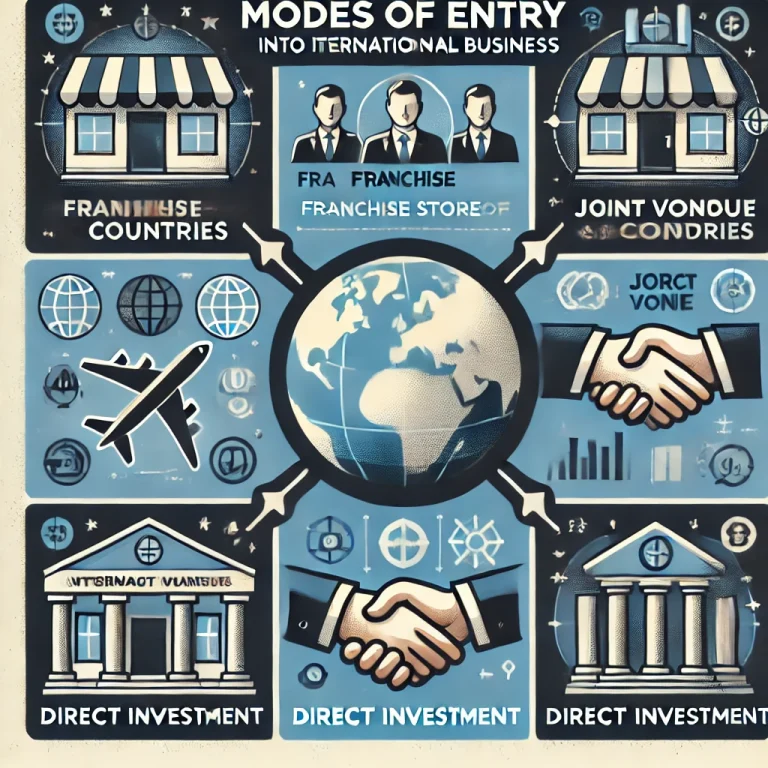Choosing the right entry mode is the first big decision that falls on a business as it decides to expand its operations beyond domestic borders. It directly influences, affects, and influences the performance, growth, and sustainability of such businesses in foreign soils. A right entry mode involves the balancing of risks, costs, control, and returns. The article discusses various modes of entering international business, thus being very helpful to businesses in making the right decisions towards going global.
What is International Business?
International business is that which relates to the international exchange of any goods, services, technology, capital, or knowledge that crosses various national borders. This includes importing, exporting, joint ventures, licensing, and many more activities. The key objective of international business is to enlarge the ambit of a company, explore new markets, and enhance profitability by exploiting opportunities around the world.
In a globalized economy, businesses venture into international trade to benefit from cheaper production costs and a new consumer base, as well as to diversify their markets. Besides, it enables companies to remain competitive through a shift in risks and the exploitation of global growth.

Modes of Entry into International Business
The modes of entry into international business define the ways through which a company can expand into foreign markets. The favorable and unfavorable features of one mode as compared to another dictate the choice. Here are the main modes of entry:
1. Exporting and Importing
Exporting is the most visible and widely used form of entry into international business. This involves the sale of goods and services produced in one country to consumers located in another. Importing is the buying of goods and services from foreign producers.
Advantages:
- Low investment risk.
- Quick market access.
- No need for a physical presence in foreign markets.
Disadvantages:
- Limited control over foreign operations.
- Vulnerable to trade barriers and tariffs.
Example: A German car manufacturer exporting vehicles to the U.S. market without setting up local production facilities.
2. Contract Manufacturing
Contract manufacturing involves a firm that hires a foreign firm to manufacture its products. This form of mode enables a business to use a foreign company’s manufacturing capabilities and keeps the marketing and branding of the products under the control of a business.
Advantages:
- Low capital investment.
- Access to local production expertise.
- Flexibility in production volumes.
Disadvantages:
- Less control over the production process.
- Potential quality issues.
Example: A U.S. electronics company outsourcing the production of its smartphones to manufacturers in China.
3. Licensing
Licensing is when a foreign company licenses your domestic company to use, for a fee or royalty, its intellectual property, brand, or production techniques. This is more common in medicine, software, and entertainment fields.
Advantages:
- Low investment cost.
- Easy market entry with minimal risk.
- Revenue generation without direct involvement.
Disadvantages:
- Limited control over operations.
- Risk of intellectual property theft or misuse.
Example: A U.K. software firm granting licensing rights to an Indian company to sell and modify its software.
4. Franchising
Franchising is a licensing mode in which a franchisor grants the rights to a franchisee to utilize its business model, brand, and operating system for a certain fee. In fast food, retail, and hospitality, for example, franchising is the most widely adopted mode of doing business.
Advantages:
- Rapid expansion with low investment.
- Franchisees handle local operations and marketing.
Disadvantages:
- Less control over brand reputation.
- Risk of inconsistent quality across franchises.
Example: McDonald’s expanding into new countries through franchising agreements.
5. Joint Ventures
A joint venture is a form of strategic alliance among two or more companies that creates a new entity in which the companies owning it are contributors to resources, capital, and expertise, while they share the risks and the rewards that this venture may bring.
Advantages:
- Shared risks and costs.
- Access to local expertise and networks.
- Enhanced market credibility.
Disadvantages:
- Potential conflicts between partners.
- Shared decision-making reduces control.
Example: A U.S. automobile manufacturer enters the Chinese market by partnering with a local carmaker to form a joint venture.
6. Wholly Owned Subsidiary
A wholly owned subsidiary is the mode in which one company fully owns and controls a foreign entity. In this mode, control over operations would be maximum as the parent company will have the ability to put its own strategies and processes in place.
Advantages:
- Full control over operations and decision-making.
- Ability to maintain consistent quality and brand image.
Disadvantages:
- High investment and operational costs.
- Increased financial risk in case of failure.
Example: A multinational corporation establishing its own manufacturing plant and distribution network in another country.
How to Select Right Mode of Entry into International Markets
Selecting the right mode of entry is crucial for the success of international expansion. Companies need to evaluate several factors to make the best choice:
1. Market Size and Growth Potential
Analyze the size of the target market and consumer preferences for market growth. Exporting may be appropriately suited to smaller, less developed markets while joint ventures or wholly owned subsidiaries may be more suitable for larger, mature markets.
2. Cost Considerations
Weigh the costs of entry, including setup, operation, and distribution costs. Licensing and franchising involve lower costs compared to establishing a wholly-owned subsidiary.
3. Control Requirements
Companies, that have full control over the aspects of production, marketing, and distribution, prefer the aspect of full ownership in fully owned subsidiaries. Licensing and franchising offer less control to such businesses that seek fast expansion with minimal involvement.
4. Risk Tolerance
Businesses should measure their risk tolerance. Exporting and licensing carry relatively lower risks. However, in joint ventures as well as wholly owned subsidiaries there is a higher risk and potentially more rewarding.
5. Legal and Regulatory Environment
Consider the legal and regulatory framework of the target country. Some markets may require local partnerships or impose restrictions on foreign ownership.
6. Cultural and Political Differences
Understand the cultural and political landscape of the target market. Joint ventures with local partners can help navigate these complexities.
Choosing the right mode of entry into international business is a strategic decision that can significantly impact a company’s success in foreign markets. By evaluating factors such as market size, cost, control, risk, and local conditions, businesses can select an entry mode that aligns with their goals and capabilities. Whether through exporting, licensing, joint ventures, or wholly owned subsidiaries, companies must carefully balance risks and rewards to thrive in the global marketplace.
Modes of Entry into International Business FAQs
What are the main modes of entry into international business?
The primary modes of entry are exporting, importing, licensing, franchising, joint ventures, contract manufacturing, and wholly owned subsidiaries.
How does a company choose the right entry mode?
Factors such as market size, cost, control, risk, and local conditions play a critical role in selecting the appropriate mode of entry.
What is the difference between exporting and franchising?
Exporting involves selling goods produced domestically to foreign markets, while franchising allows a foreign entity to operate a business using the franchisor’s model and brand.
What are the risks associated with joint ventures?
Potential risks include conflicts between partners, shared control, and difficulties in integrating different business cultures.
Why do companies opt for wholly owned subsidiaries?
Companies choose wholly owned subsidiaries when they want full control over foreign operations, branding, and strategic decisions.


